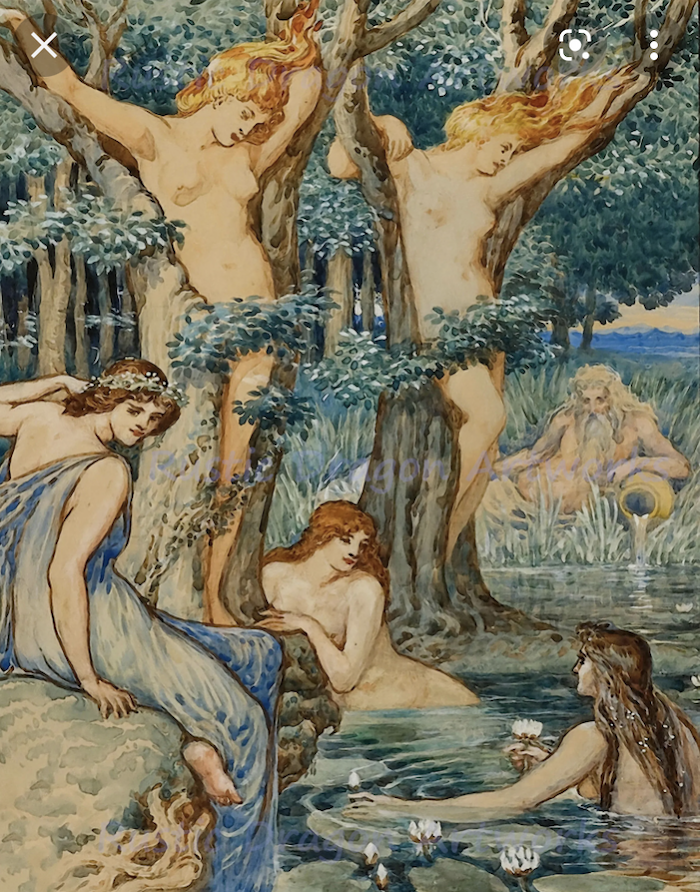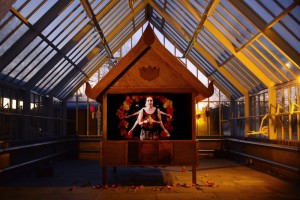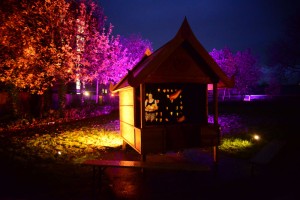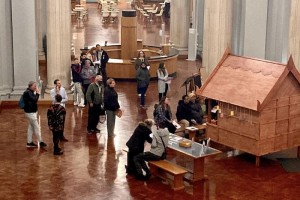Émile Bin (1825–1897), The Hamadryad (1870)
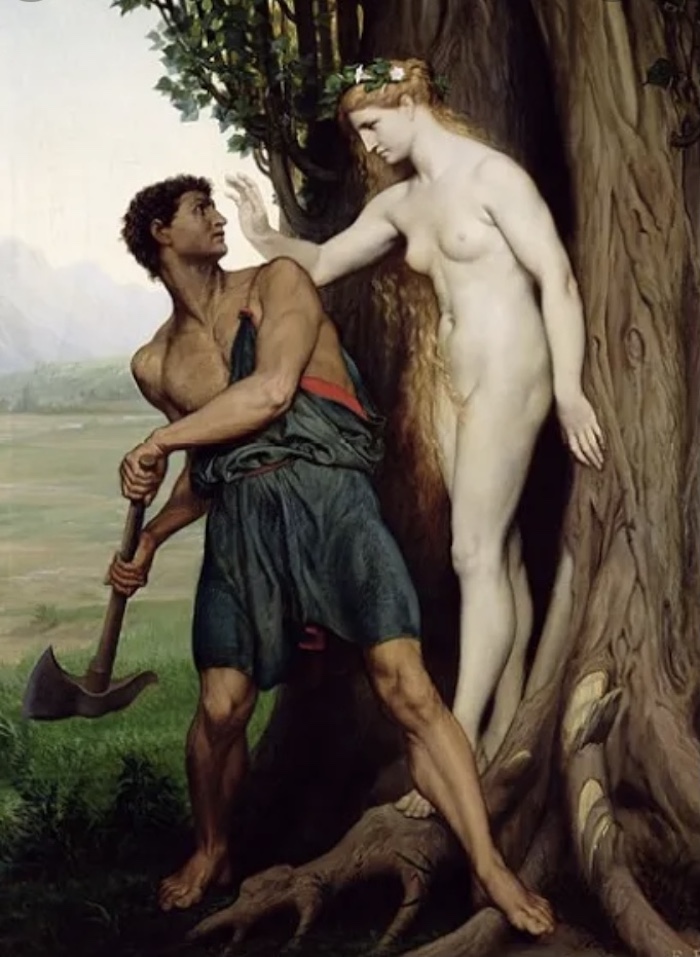
Kodama, the tree spirit (Japanese culture)
The Japanese have always known that some trees were special. For whatever reason—maybe because of an interestingly shaped trunk, or a sequence of knots resembling a human face, or just a certain sense of awe—some trees were identified as being the abodes of spirits. Depending on where you lived, these spirits went by many names. But the most common term, the one that is still used today, is kodama.
In ancient times, kodama were said to be kami, nature dieties that dwelled in trees. Some believed that kodama were not linked to a single tree but could move nimbly through the forest, traveling freely from tree to tree.
Still others believed that kodama were rooted like the trees themselves, or in fact looked no different from other trees in the forest. Woe betide any unwary woodsman who took an axe to what looked like a regular tree, only to draw blood as he chopped into a kodama. A kodama’s curse was something to be feared.
But they were also a sound. Echoes that reverberated through mountains and valleys were said to be kodama. The sound of a tree crashing in the woods was also said to be the plaintive cry of a kodama. (In modern times this mountain echo is associated with the yokai yamabiko and not with kodama).
The first known mention of tree spirits is in Japan’s oldest known book, the Kojiki (Record of Thing’s Past) that talks about the tree god Wakunochi-no-kami, second born of the godling brood of Izanagi and Izanami.
The oldest, specific known use of the term kodama comes from the Heian period, in the book Wamuryorui Jyusho (和名類聚抄; Japanese Names for Things; written 931 – 938 CE). Wamuryorui Jyusho was a dictionary showing the appropriate kanji for Japanese words, and listed古多万 as the Japanese word for spirits of the trees. Another Heian era book, Genji Monogatari (源氏物語; The Tale of Genji), uses木魂 to describe kodama as sort of tree-dwelling goblin. Genji Monogatari also uses the phrase “either oni or kami or kitsune or kodama,” showing that these four spirits were thought to be separate entities.
Around the Edo period, kodama lost their rank as gods of the forest and were included as just one of Japan’s ubiquitous yokai. Kodama became humanized as well—there are stories of kodama falling in love with humans and taking human shape in order to marry their beloved.
In Aogashima, Izu Islands, people place small shrines at the base of cryptomeria (Japanese cedar) trees and still worship and pray to them. This is said to be the remainders of a nature-worshiping religion that once dominated.
In Mitsune village, in Hachijō-jima, they still have a festival every year giving thanks and respect to “kidama-san” or “kodama-san,” hoping for forgiveness and blessing when they cut down trees for the logging industry.
In Okinawa, they call the tree spirit kinushi. At night, if you hear the sound of a falling tree it is said to be the cry of a kinushi, and Okinawa’s tree-dwelling famous yokai kijimuna is thought to be a descendant of these ancient kinushi tree spirits.
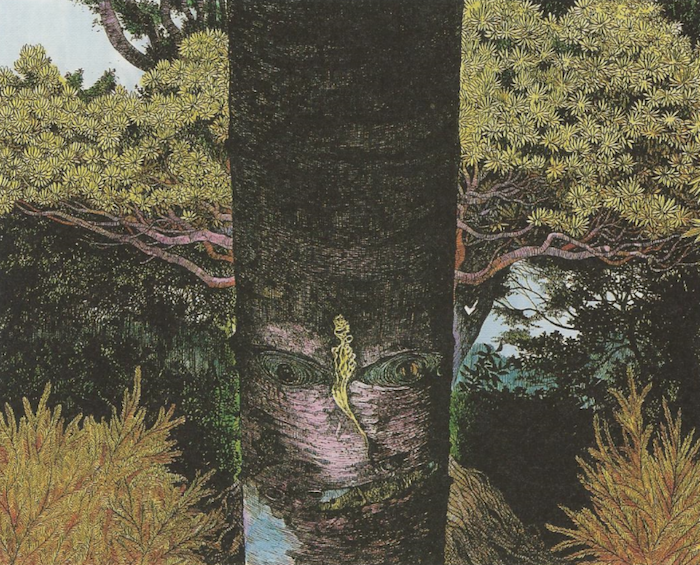
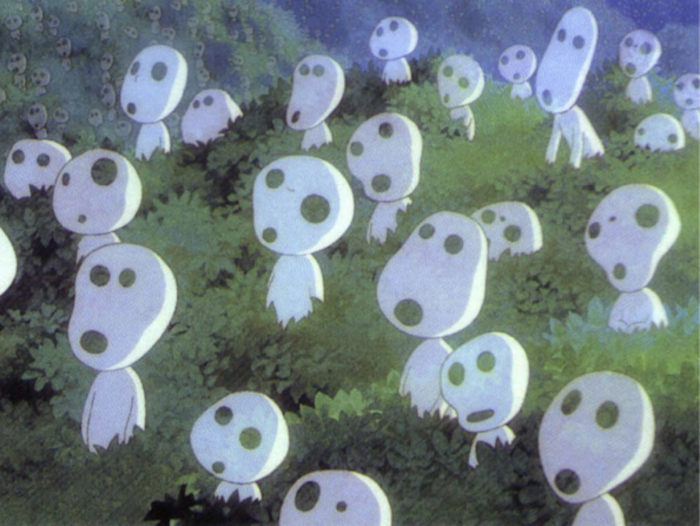
Ki no Kami, The God in the tree (Japanese culture)
Translated from Mizuki Shigeru’s Mujara
From ancient times in Japan, certain types of trees were thought to be abodes for kami, the spiritual deities of Japan’s native animistic religion. Specific trees such as the Chinese bunyan tree or the Indian laurel were said to be favored by these kami. The importance of these tree-dwelling kami was established in the Kojiki (Record of Ancient Matters), where the legend is told of the founding sibling gods of Japan Izanagi and Izanami. The two gave birth to hundreds of thousands of godling children, but their second-born was the kami of the trees.
All around Japan you can see trees that resemble humans in some uncanny way. Legends say this comes from the kami spirits who dwell inside. Called Jiyushin (), shinboku (神木), or kodama (古多万), these sacred trees are often found on the grounds of Shinto shrines or Buddhist temples. The spirits that dwell in the trees are said to offer protection to worshipers and watch over homes in the vicinity.
At the same time, these trees offer protection to the kami themselves, giving them a physical space to inhabit. It is sometimes said that the kami come down to earth from heaven, but they cannot remain in their natural state. The holy trees act as a medium, giving the spiritual essence of the kami somewhere to exist while they are in the human realm. They resonate with trees of a certain shape—it is said spiritual energy of the kami can be felt the most strongly in trees that have double, or even triple, trunks.
There are still shrines throughout Japan that venerate local tree-dwelling kami. Many of these are found in the mountains, where the trees are said to be inhabited by various mountain kami or even ancestor spirits. But no matter the origin, when they kami take up residence in a tree they are called ki no kami, the gods in the trees.
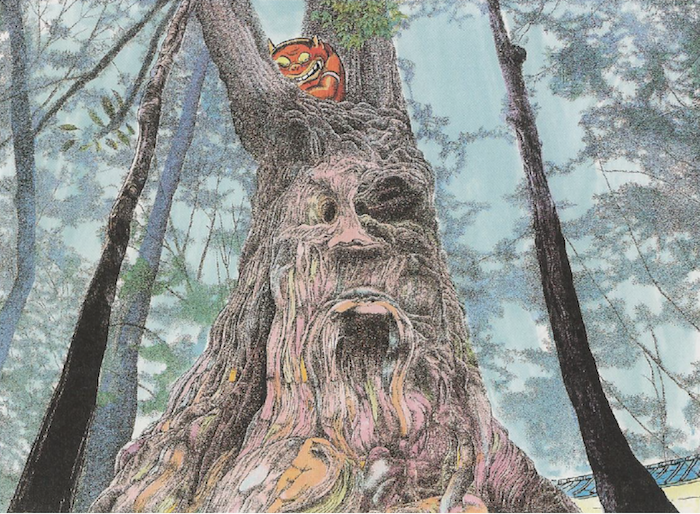
Moidon, the Lord of the Forest (Japanese Culture)
The Moidon’s name tells you exactly what it is. The word moi (森) means “forest,” and the word don (殿) means “Lord.” It is a title of honor bestowed upon grand and aged trees. In ancient Japan, long before there was any sort of organized religion, people believed that these great trees were deities and the land they inhabited was a sacred space. Southern Kyushu in particular is home to moidon, although on Osumi peninsula they are called moriyama. In Kagoshima prefecture you can find more than a hundred moidon.
Long before any shrines were built, moidon served as places of worship to the ancient Japanese. Very old and massive trees were said to be the bodies for gods. In particular, broad-leaf evergreen trees were considered to be moidon, such as beech, camphor, and fig trees. In modern day Shinto, you can still see moidon that existed long before the buildings were built. Indeed, many of those oldest shrines were built around a particular moidon, as the area was already considered a sacred space by virtue of the tree.
In Hioki ward, Ichiki city, there is a moidon whose festival is celebrated every year. On November 5th, by the counting of the old Japanese lunar calendar, people eat festive red rice to mark the occasion, and a dish is always set in front of the tree as an offering. However it is said that if you take a single leaf home, or if any part of the great tree is burned as firewood, you will fall under its curse.
Moidon were long worshiped as gods, but they were also greatly feared. It is said that moidon are quick to take offense, and bestow curses more readily than blessings. Those who ask too much of them, or who gather their fallen branches to burn, will find themselves stricken with various illnesses, including a burning, itchy skin. Sometimes doing so much as to touch the tree brings about its curse, so villagers are often careful to give their moidon trees a wide birth except at festival time.
Because of their ability to curse, it is thought that these lords of the forest may be one of the origins of yokai legends throughout Japan.
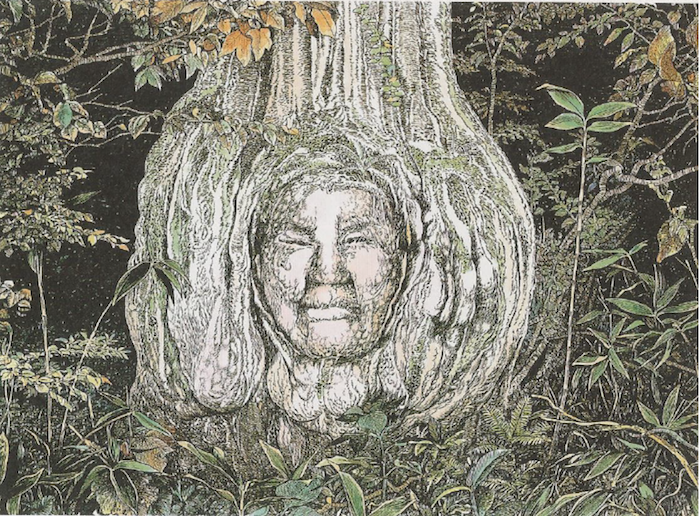
Jinmenju, the human face tree (Japanese culture)
Translated from Mizuki Shigeru’s Mujyara
This tree is found in mountain valleys. The fruit of the tree looks like a human head. It doesn’t say a word, but it is constantly laughing. It is said that if the fruit laughs too heartily, it falls from the tree.
According to the Edo period Hyakka Jiten encyclopedia Wakan Sansai Zue (和漢三才図会; A Collection of Pictures of Heaven, Earth, and Man from China and Japan), the Jinmenju trees are found in the south, and the fruit of the tree is called the jinmenshi, or human-faced child. They ripen in the fall, and if you eat the fruit they have a sweet/sour taste. It is said that the Jinmenju seed also has a human face, eyes, ears, nose, and mouth. It is possible that the trees were all eaten and it is why we don’t see them today.
In the past however, it was said that people planted great orchards of the laughing Jinmenju. That must have been a beautiful sight.
The legend of the Jinmenju comes from China, and was passed onto Japan where it was considered to be a yokai due to its peculiar nature. There are also stories of trees bearing human-faced fruit from India and Persia, usually with the faces of beautiful girls. Even now, when you walk through the forest you can see trees whose roots bear a resemblance to human and yokai faces. I have five pictures of trees like this in my photo albums. I wonder if this is some new species of Jinmenju?
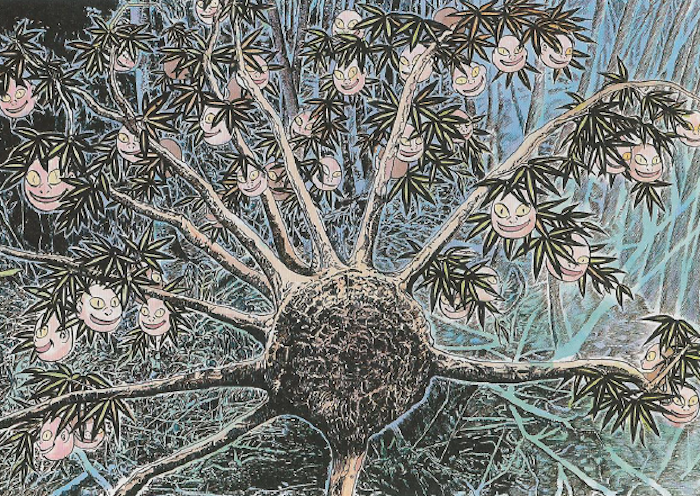
Yamauba, mountain nurse, or river lady (Japanese culture)
The word can also be written as 山母, 山姫, or 山女郎, and in the town of Masaeki, Nishimorokata District, Miyazaki Prefecture (now Ebino), a “yamahime” would wash her hair and sing in a lovely voice. Deep in the mountains of Shizuoka Prefecture, there is a tale that the “yamahime” would appear as a woman around twenty years of age and would have beautiful features, a small sleeve, and black hair, and that when a hunter encounters her and tries to shoot at it with a gun, she would repel the bullet with her hands. In Hokkaido, Shikoku, and the southern parts of Kyushu, there is also a yamajijii (mountain old man), and the yamauba would also appear together with a yamawaro (mountain child), and here the yamauba would be called “yamahaha” (mountain mother) and the yamajijii a “yamachichi” (mountain father). In Iwata District, Shizuoka Prefecture, the “yamababa” that would come and rest at a certain house was a gentle woman that wore clothes made of a tree’s bark. She borrowed a cauldron to boil some rice, but the cauldron would become full with just two go of rice. There wasn’t anything unusual about it, but it was said that when she sat to the side of it, the floor would creak. In Hachijō-jima, a “dejji” or “decchi” would perform kamikakushi by making people walk around places that should not exist for an entire night, but if one becomes friendly with her, she would lend you lintel, among other things. Sometimes she would also nurse children who go missing for three days. It is said that there are splotches on her body and she has her breasts attached to her shoulders as if there was a tasuki cord. In the Kagawa Prefecture, yamauba within rivers are called “kawajoro” (river lady),[3] and whenever a dike is about to break due to a great amount of water, she would say in a loud weeping voice, “My house is going to be washed away.”[4] In Kumakiri, Haruno, Shūchi District, Shizuoka Prefecture (now Hamamatsu), there are legends of a yamauba called “hocchopaa”, and it would appear in mountain roads during the evening. Mysterious phenomena, such as the sounds of festivals and curses coming from the mountains, were considered to be because of this hocchopaa.[5] In the Higashichikuma District, Nagano Prefecture, they are called “uba”, and the legends there tell of a yokai with long hair and one eye,[6] and from its name, it is thought to be a kind of yamauba.[7]
In the tales, the ones attacked by yamauba are typically travelers and merchants, such as ox-drivers, horse-drivers, coopers, and notions keepers, who often walk along mountain paths and encounter people in the mountains, so they are thought to be the ones who had spread such tales.
Yamauba have been portrayed in two different ways. There were tales where men stocking ox with fish for delivery encountered yamauba at capes and got chased by them, such as the Ushikata Yamauba and the Kuwazu Jobo, as well as a tale where someone who was chased by the yamauba would climb a chain appearing from the skies in order to flee, and when the yamauba tried to make chase by climbing the chain too, she fell to her death into a field of buckwheat, called the “Tendo-san no Kin no Kusari”. In these tales, the yamauba was a fearsome monster trying to eat humans. On the other hand, there were tales such as the Nukafuku Komefuku(also called “Nukafuku Kurifukk”), where two sisters out gathering fruit met a yamauba who gave treasure to the kind older sister (who was tormented by her stepmother) and gave misfortune to the ill-mannered younger sister. There is also the “ubakawa” tale, where a yamaba would give a human good fortune. In Aichi Prefecture, there is a legend that a house possessed by a yamauba would quickly gain wealth and fortune, and some families have deified them as protective gods.
Depending on the text and translator, the Yamauba appears as a monstrous crone, “her unkempt hair long and golden white … her kimono filthy and tattered”,[8] with cannibalistic tendencies.[9] In one tale a mother traveling to her village is forced to give birth in a mountain hut assisted by a seemingly kind old woman, only to discover, when it is too late, that the stranger is actually Yamauba, with plans to eat the helpless Kintarō.[10] In another story the yōkai raises the orphan hero Kintarō, who goes on to become the famous warrior Sakata no Kintoki.[11]
Yamauba is said to have a mouth at the top of her head, hidden under her hair.[12] In one story it is related that her only weakness is a certain flower containing her soul.
“Yamauba” (山うは) from the Hyakkai Zukan by Sawaki Suushi, “Yamauba” (山姥) from the Gazu Hyakki Yagyō by Toriyama Sekien, A depiction of Yama-uba by Totoya Hokkei (1780–1850), Yamauba, Hair Undone, by Hokusai, Yama-uba Nursing Kintoki, Kitagawa Utamaro 1802
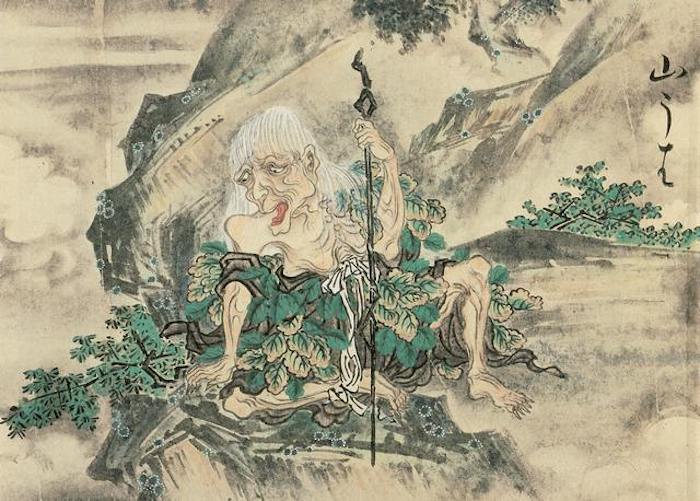
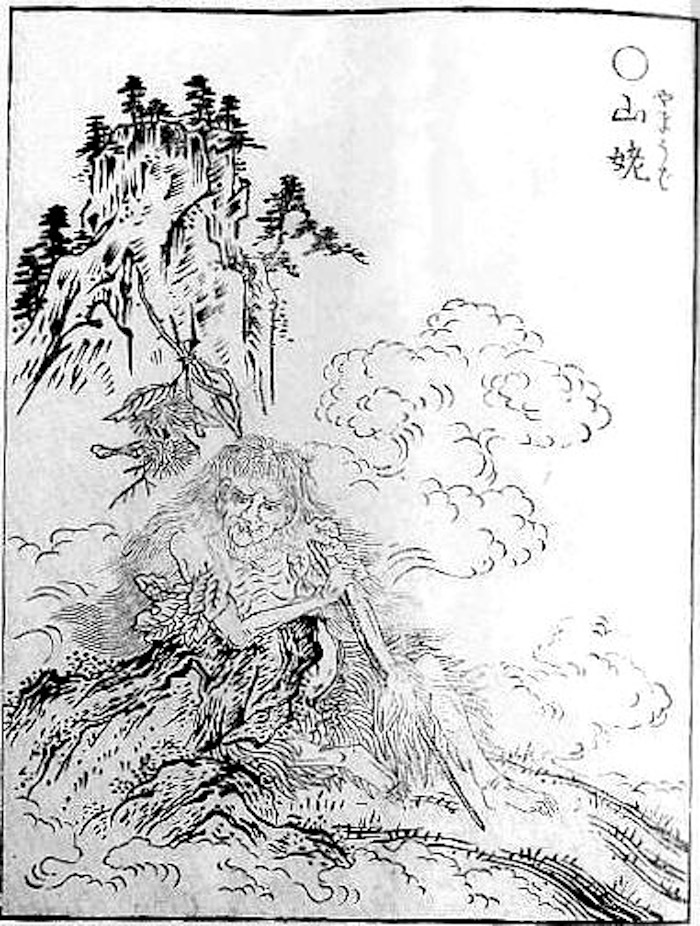
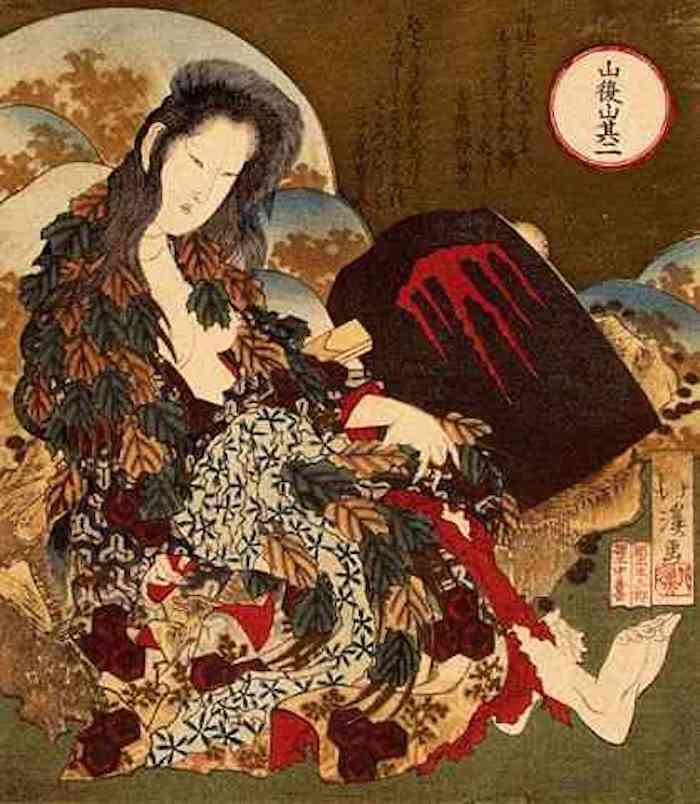
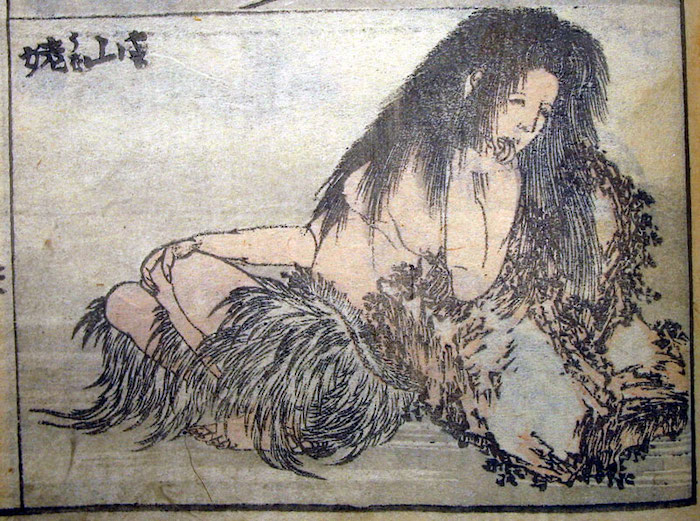
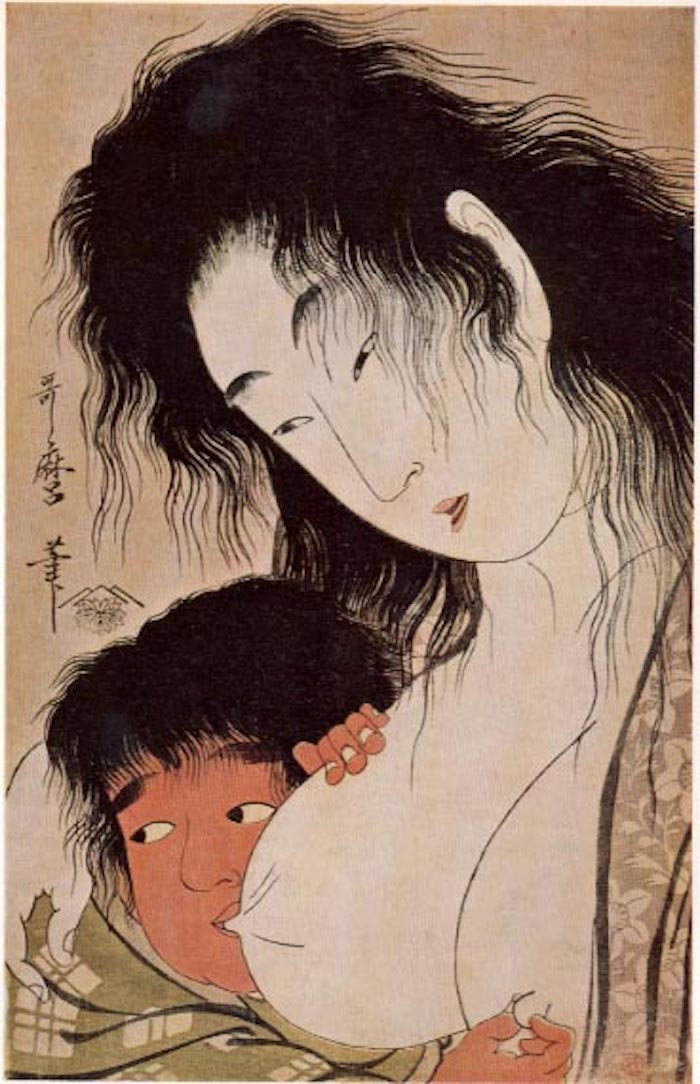
The Bodhi tree
The Bodhi Tree (“tree of awakening”[1]), also called the Bodhi Fig Tree or Bo Tree,[2] was a large and ancient sacred fig tree (Ficus religiosa[1][3]) located in Bodh Gaya, Bihar, India. Siddhartha Gautama, the spiritual teacher who became known as the Buddha, is said to have attained enlightenment or Bodhi circa 500 BCE under it.[4] In religious iconography, the Bodhi Tree is recognizable by its heart-shaped leaves, which are usually prominently displayed.[5]
The proper term “Bodhi Tree” is also applied to existing sacred fig (Ficus religiosa) trees, also known as bodhi trees.[6] The foremost example of an existing tree is the Mahabodhi Tree growing at the Mahabodhi Temple in Bodh Gaya, which is often cited as a direct descendant of the original tree. This tree, planted around 250 BCE, is a frequent destination for pilgrims, being the most important of the four main Buddhist pilgrimage sites.[7]
Other holy bodhi trees with great significance in the history of Buddhism are the Anandabodhi Tree at Jetavana in Sravasti in North India and the Sri Maha Bodhi Tree in Anuradhapura, Sri Lanka. Both are also believed to have been propagated from the original Bodhi Tree.
On December 8, Bodhi Day celebrates Buddha’s enlightenment underneath the Bodhi Tree. Those who follow the Dharma[dubious – discuss] greet each other by saying, “Budu saranai!” which translates to “may the peace of the Buddha be yours.”[8] It is also generally seen as a religious holiday, much like Christmas in the Christian west, in which special meals are served, especially cookies shaped like hearts (referencing the heart-shaped leaves of the Bodhi) and a meal of Kheer, the Buddha’s first meal ending his six-year asceticism.[9]
Bodhi Puja, meaning “the veneration of Bodhi-tree” is the ritual to worship the Bodhi tree and the deity residing on it (Pali: rukkhadevata; Sanskrit; vrikshadevata). It is done by giving various offerings such as food, water, milk, lamps, incense, etc. and chanting the verses of glory of Bodhi tree in Pali. The most common verse is:
“Ime ete mahabodhi lokanathena pujita ahampi te namassami bodhi raja namatthu te.”
Below, image buddha head in Bodhi tree, Ayutthaya, Thailand, llustration of the temple built by Asoka at Bodh-Gaya around the Bodhi tree. Sculpture of the Satavahana period at Sanchi, 1st century CE, and contemporary print by Satchita Melina
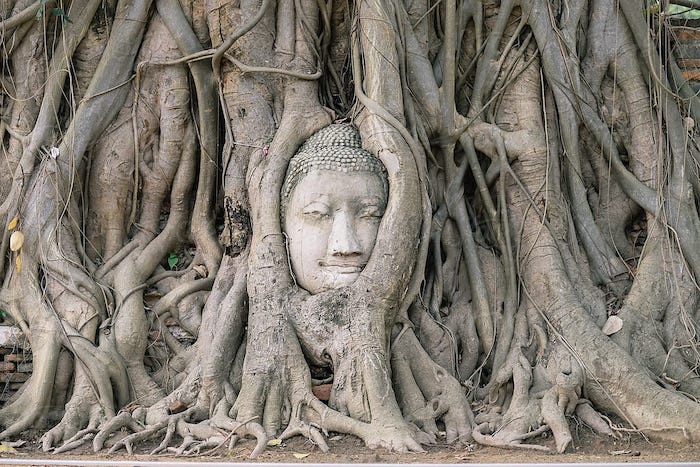
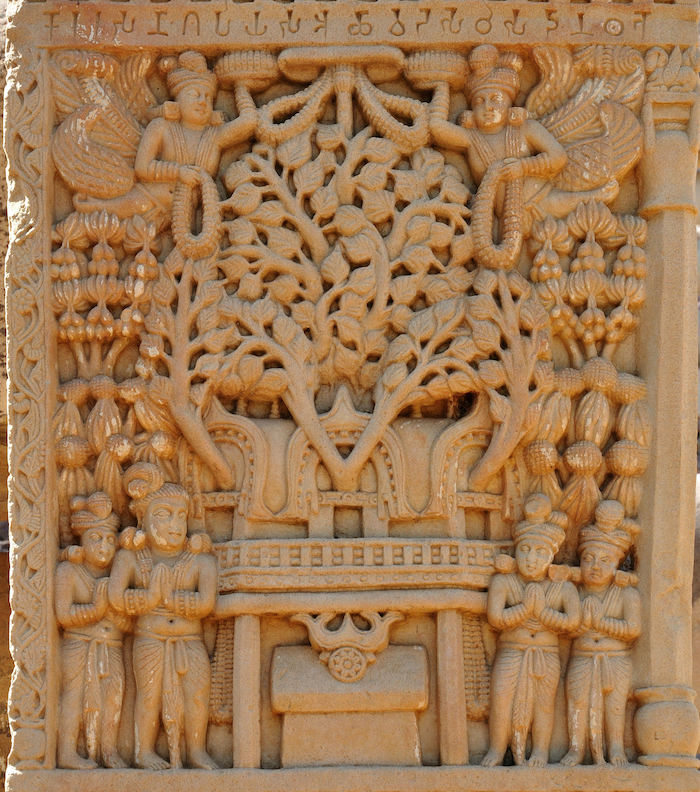
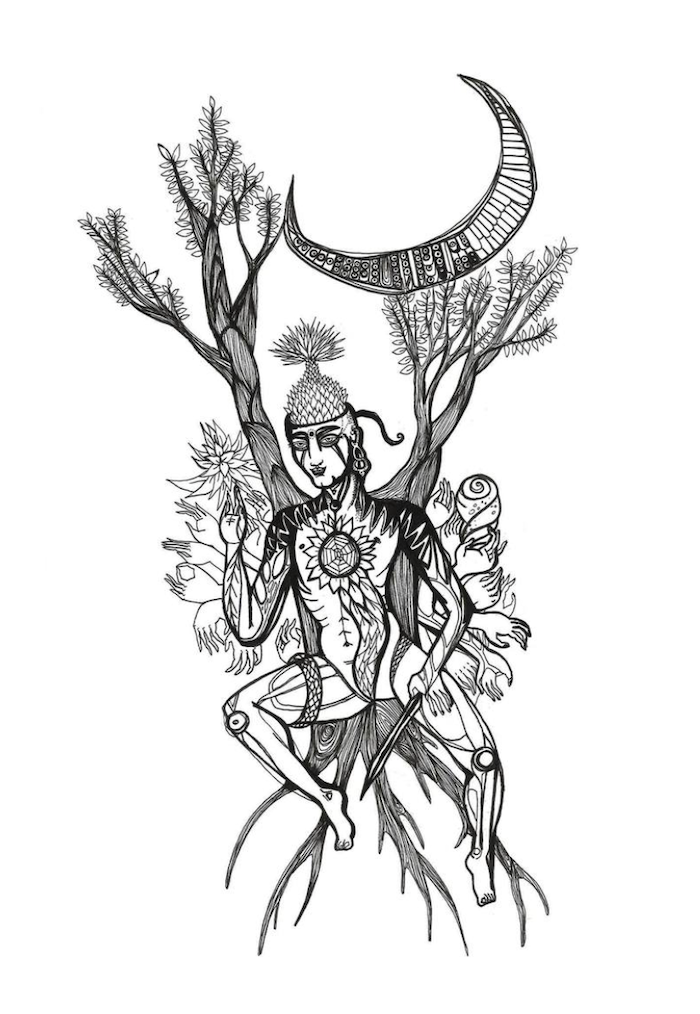
Curupira, protector of the forest (Brazilian culture)
Curupira (Tupi: kuru’pir, The Covered with Pustules or Boy’s Body) is a creature of Brazilian folklore and mythology. It is an entity that protects the forests and animals from hunters. It inhabits the woods and its main feature are its feet turned back.
The Curupira (Portuguese pronunciation: [kuɾuˈpiɾɐ]) is a mythological creature of Brazilian folklore. This creature blends many features of West African and European fairies, but was usually regarded as a demonic figure.[citation needed]
The name comes from the Tupi language kuru’pir, meaning “covered in blisters”. According to the cultural legends, this creature has bright red/orange hair, and resembles a man or a dwarf, but its feet are turned backwards. Curupira lives in the forests of Brazil and uses its backward feet to create footprints that lead to its starting point, thus making hunters and travelers confused. Besides that, it can also create illusions and produce a sound that is like a high pitched whistle, in order to scare and drive its victim to madness. It is common to portray a Curupira riding a collared peccary, much like another Brazilian creature called Caipora.[citation needed]
A Curupira will prey on poachers and hunters that take more than they need of the forest, and he also attacks people who hunt animals that were taking care of their offspring. There are many different versions of the legend, and so the creature’s appearance and habits may vary from each region in Brazil. However, Curupira is considered a nationwide folkloric figure
A being called the Demon Curupira was featured in several episodes of the 1999 – 2002 television series BeastMaster. Played by Australian actress Emilie de Ravin, this Curupira, while still possessing the backwards feet, had the appearance of a young and deceptively sweet-faced blonde girl clad in green. She was a spirit of the forest and very capricious; she protected the animals, particularly tigers, and with a kiss she could drain humans of their lives, reducing their bodies to mere husks. She was an uneasy ally of the title character, Dar.
The Netflix Series of 2021 Invisible City features numerous characters of Brazilian Lore, including Curupira. Curupira, played by Fabio Lago is portrayed as a homeless person who is actually an entity that guards and protects Brazilian forests, perceived by his backward feet, flaming head, and illusion-like high whistles that combine nature and human voices.
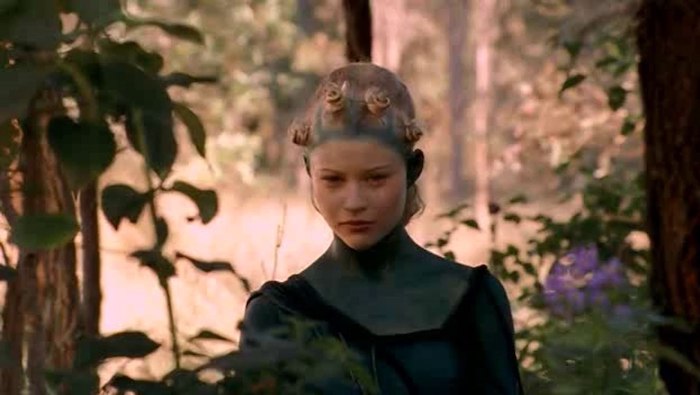
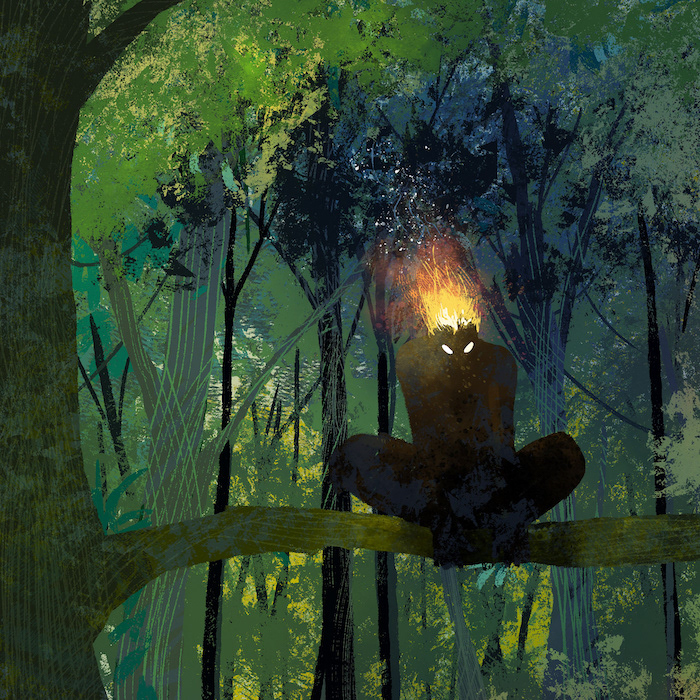
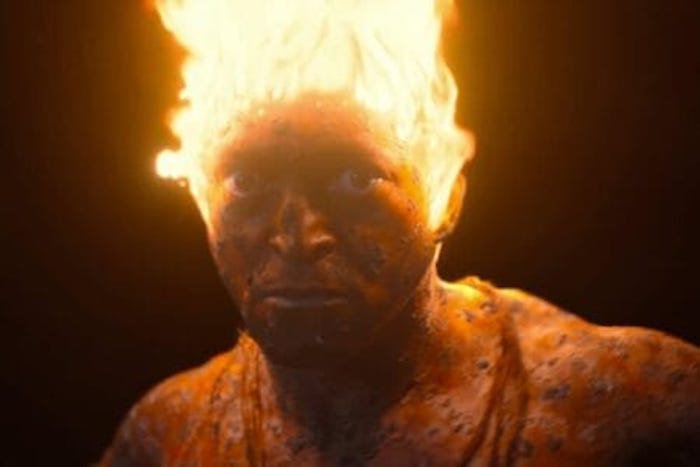
Naiades, nymphs of freshwater streams (Ancient Greece)
The Naiades were the nymphs of freshwater streams rivers and lakes, but were not limited to these water courses. Many Naiades could be found prancing around with Artemis, who chose 20 Naiades from Amnisus for companions. Naiads were the most prominent type of Water Nymph, they comprised not only the daughters of Okeanos and Tethys but daughters of river gods. Because of this, unlike the Nephelai, Leimonides and Anthousai not all Naiads were Okeanides. Naiades had extremely long lifetimes, but they were not considered immortal, and were believed to have sat in on the Gods discussions on Olympus. There were 5 types of Naiades:
- Pegaiai, the Nymphs of Springs
- Krenaiai, the Nymphs of Fountains
- Potameides, the Nymphs of Rivers and Streams
- Limnades or Limnatides, the Nymphs of Lakes
- Eleionomai, the Nymphs of Marshes
Below, Adolphe Lalire Danse des niades

Dryads, tree nymphs (Ancient Greece)
Images below The Dryad by Evelyn de Morgan, Émile Bin’s The Hamadryad, John William Waterhouse (1849–1917), Hamadryad (1893-95), the last driad by Gabriel Guay (1848- 1923)
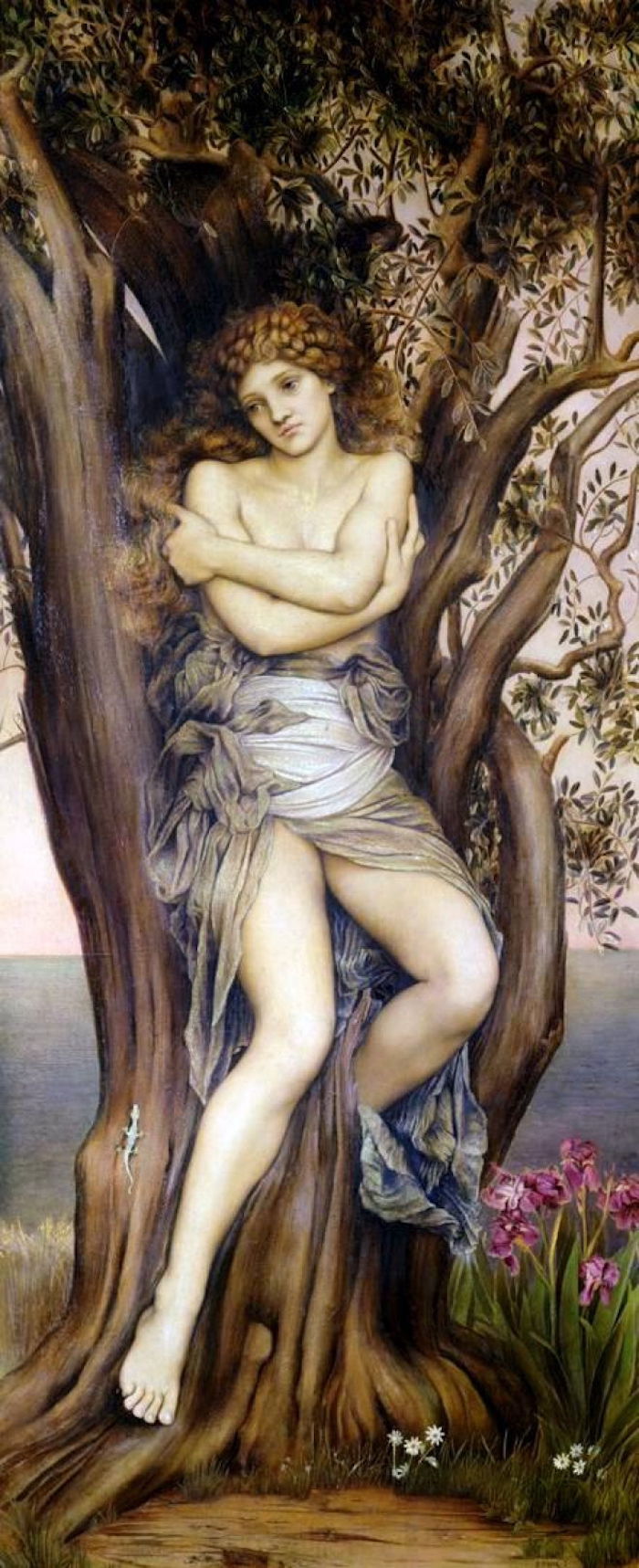
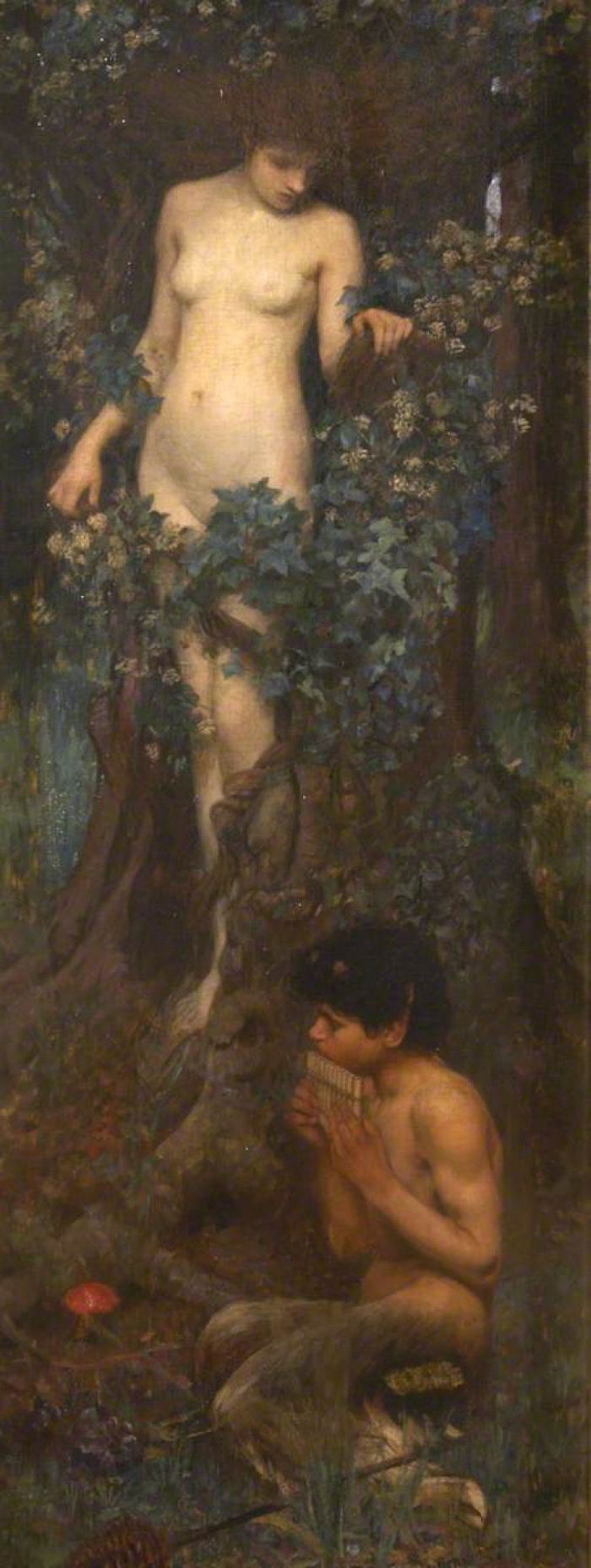
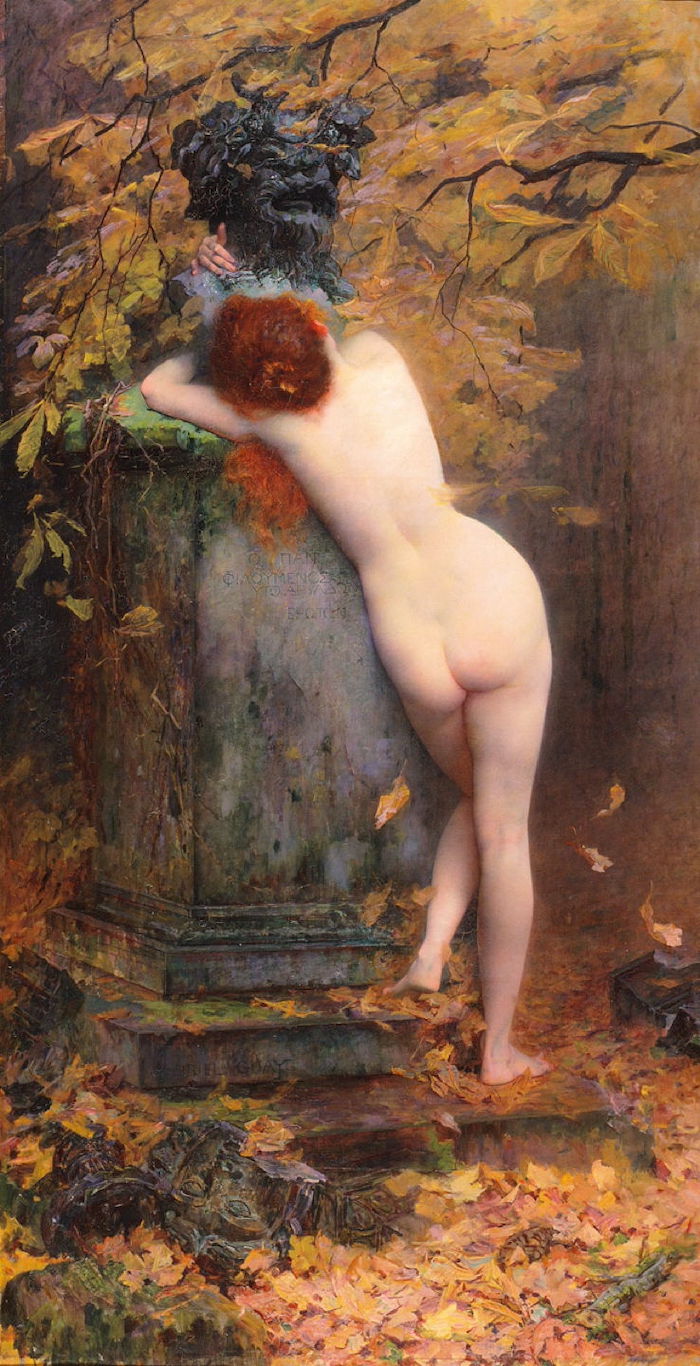

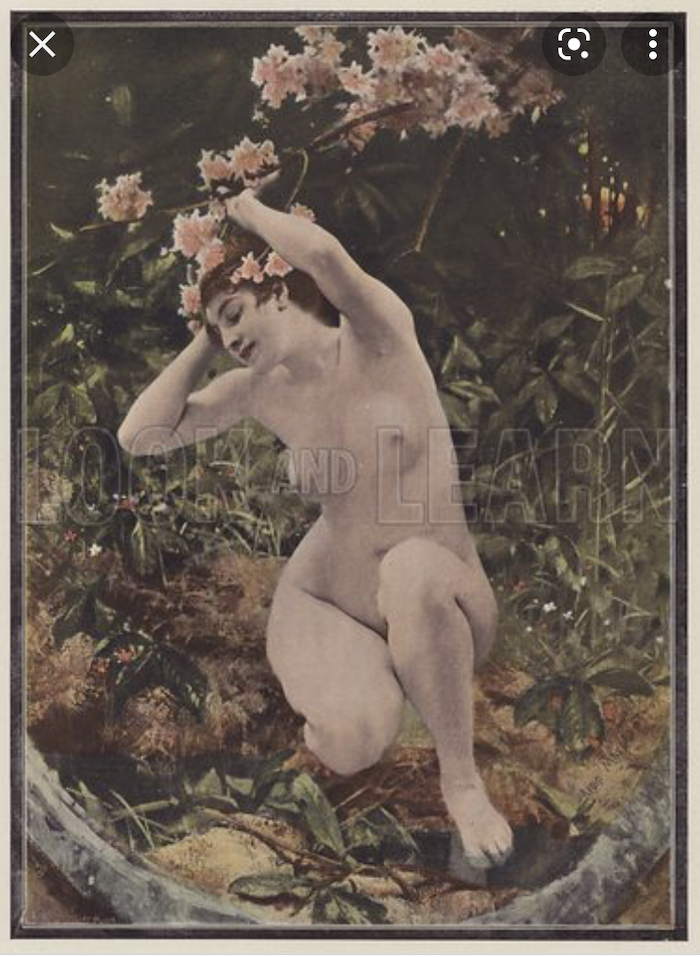
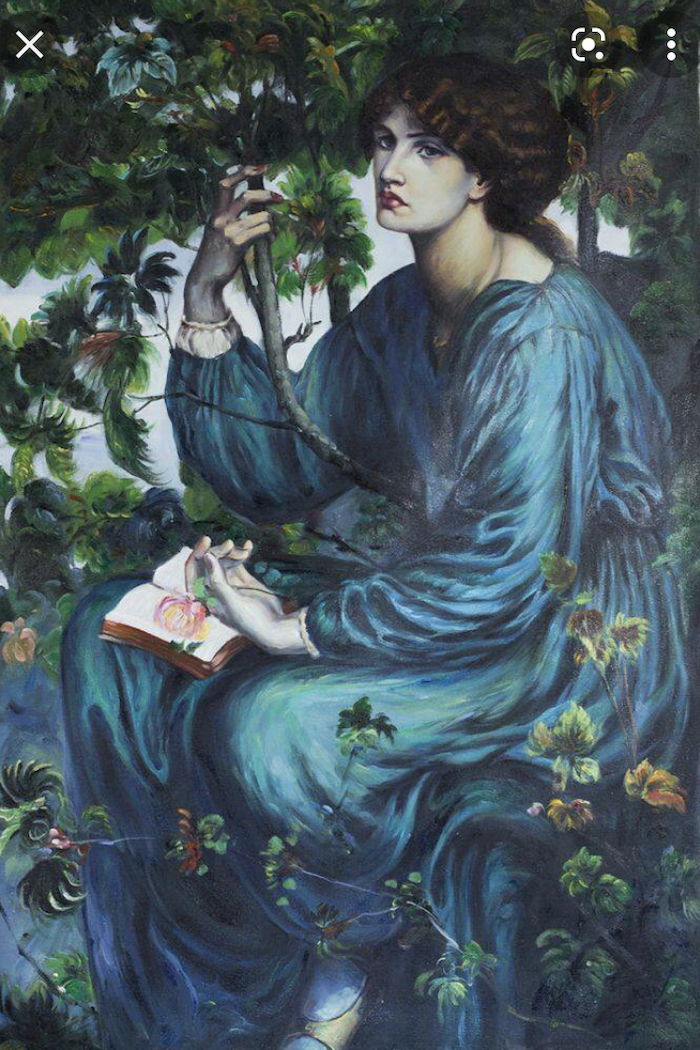
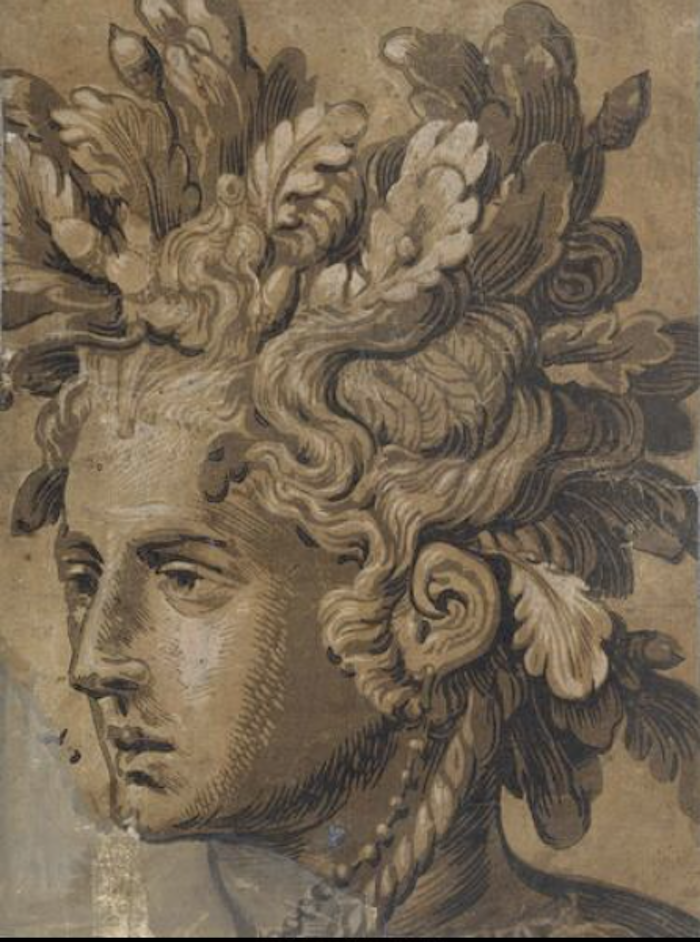
Dryads and Nyads by Walter Crane
